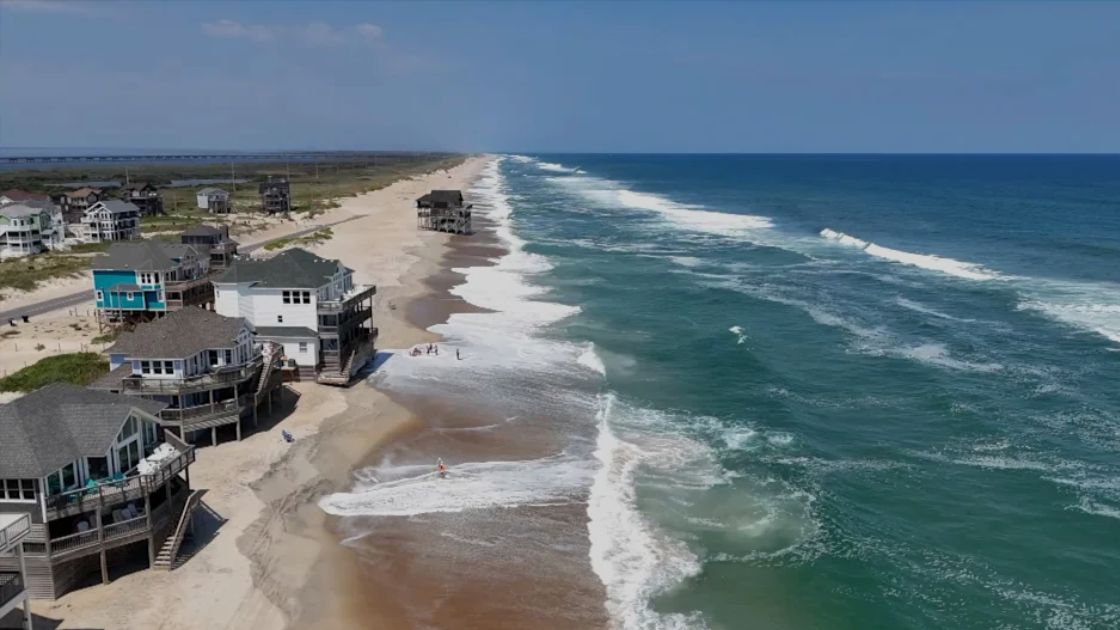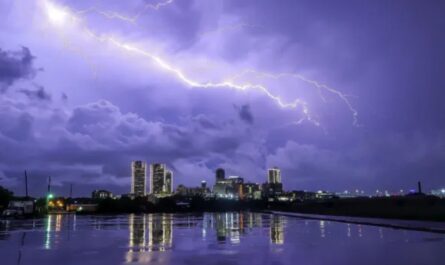Hatteras, North Carolina – A dangerous and potentially life-threatening situation is unfolding along the East Coast as tropical storm alerts have been issued for parts of coastal Virginia and North Carolina’s Outer Banks while Hurricane Erin churns offshore.
Although Erin is not forecast to make landfall in the United States, forecasters warn that the system’s outer rainbands and strong winds could brush the Mid-Atlantic coast in the coming days. The storm is also producing large waves and life-threatening rip currents, prompting multiple states to close beaches and suspend water activities.
North Carolina and Virginia Brace for Impacts
The Outer Banks of North Carolina are on high alert as the storm’s outer circulation pushes tropical-storm-force winds and heavy rain closer to the coast. Officials say residents and visitors should expect beach erosion, coastal flooding, and dangerous marine conditions through the end of the week.
In Virginia, alerts have also been expanded to cover portions of the coast, with authorities warning boaters and beachgoers to avoid entering the water. Emergency management officials say the biggest threats are rip currents and large waves, which could persist for several days even as Erin moves north.
New York and New Jersey Close Beaches
Farther north, New York City officials announced that all public beaches are closed for swimming on Wednesday and Thursday due to dangerous surf. The decision comes as massive waves generated by Erin pound the Atlantic shoreline, creating rip currents that could prove deadly.
In New Jersey, Island Beach State Park has suspended swimming, mobile sport fishing vehicle access, and recreational programs through at least Thursday. Local police departments, including those in Wildwood, are urging residents to obey all restrictions.
“The Wildwood Beach Patrol advises everyone to stay out of the water and to heed all warnings,” the department said, stressing that the rule applies even after lifeguards are off duty.
Maryland Beaches Issue Red Flag Warnings
In Maryland, officials at Assateague State Park have also banned swimming and water entry because of pounding surf and fast-moving currents. On Tuesday, red flags were raised to warn beachgoers to stay out of the water as Hurricane Erin remained offshore.
Nearby, the Margate City Beach Patrol went further, prohibiting swimming, bathing, surfing, and kayaking until further notice.
“This wasn’t a decision we came to lightly,” the patrol said in a statement. “Our priority is the safety of our beachgoers and lifeguards.”
Erin Strengthens Offshore but Stays Dangerous
According to the National Hurricane Center (NHC), Erin is currently producing maximum sustained winds near 100 mph with higher gusts, and some fluctuations in strength are expected in the coming days.
The storm underwent a period of rapid intensification last week, exploding from a Category 1 hurricane to a Category 5 monster with winds of 160 mph in just hours. While Erin has since weakened, forecasters emphasize that the storm has grown in size, expanding its reach along the coast.
Read Also: La Niña Watch Issued as Monsoon Season Brings Warm Weather and Fire Risk to San Diego
“Hurricane-force winds now extend outward up to 80 miles from the center,” the NHC reported, “and tropical-storm-force winds extend outward as far as 205 miles. This forecast brings tropical-storm-force winds very close to the Mid-Atlantic and southern New England later this week.”
What Residents Should Expect
Forecasters warn that strong rip currents, heavy surf, and localized coastal flooding are the most likely threats along the East Coast. Even without a direct landfall, conditions will remain hazardous for swimmers, surfers, and small craft operators.
Residents in affected areas are urged to:
- Avoid entering the water until local restrictions are lifted.
- Stay updated with the National Hurricane Center’s advisories.
- Be prepared for potential localized flooding and power outages along the coast.
Final Thoughts
Hurricane Erin may remain offshore, but its broad wind field and massive waves mean the East Coast will not be spared from impacts. From the Outer Banks of North Carolina to New York and New Jersey beaches, officials are prioritizing safety by restricting swimming and recreational water use.
Do you think coastal states are doing enough to prepare for storms like Hurricane Erin, even when landfall isn’t expected? Share your thoughts in the comments at ibwhsmag.com.


 by
by 

